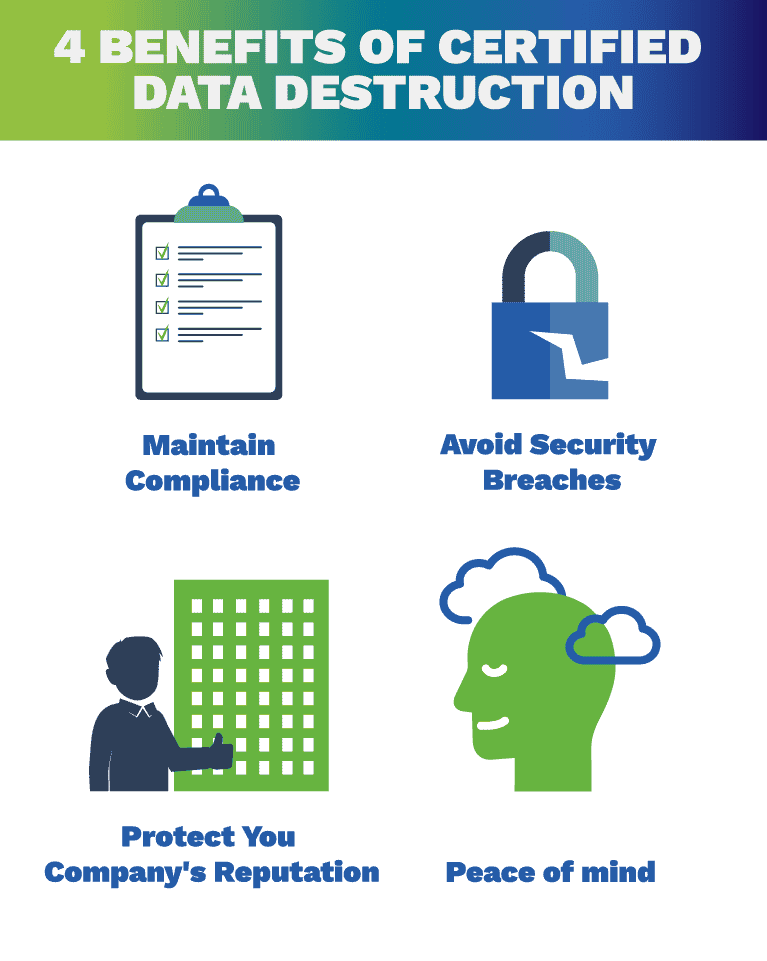Recognizing the Function of Data Destruction in Strengthening Cyber Security Defenses
Wiki Article
The Relevance of Effective Data Destruction Practices in Shielding Sensitive Info and Ensuring Computer Safety And Security
In an age where data violations are significantly usual, the importance of effective data destruction techniques can not be overemphasized. Executing durable information damage approaches not just alleviates these threats however also straightens with lawful compliance requirements, making certain that organizations maintain their reputation and foster customer trust fund.Understanding Data Devastation
Recognizing data devastation is vital in today's electronic landscape, where delicate information can easily be jeopardized. Efficient data devastation includes not simply making sure but erasing files that information is irretrievable through detailed methods. This process is necessary for companies that deal with confidential customer information, intellectual property, or interior records, as any type of violation can bring about extreme financial and reputational consequences.
Information devastation includes different methods, including shredding physical media, degaussing magnetic storage tools, and using software-based remedies that overwrite information several times. Each approach serves a particular function and should align with the level of sensitivity of the info being disposed of. For instance, physical damage is frequently liked for disk drives having extremely private information, while software approaches could be adequate for less delicate info.
Additionally, sticking to market standards and guidelines, such as the General Data Protection Regulation (GDPR) or the Medical Insurance Transportability and Responsibility Act (HIPAA), is necessary for conformity and to alleviate legal dangers. Organizations needs to establish a robust information damage policy, train staff members on best practices, and consistently investigate their treatments to guarantee that all sensitive details is thrown away firmly and efficiently.
Threats of Inadequate Practices
Inadequate data damage techniques subject companies to significant threats that can have far-reaching effects. When sensitive info is not appropriately dealt with, it remains prone to unapproved accessibility, which can bring about data violations and identity theft. Such events not just compromise the safety of people however likewise tarnish the organization's online reputation, leading to a loss of consumer depend on and prospective financial consequences.Moreover, governing compliance is progressively strict in many sectors. Failing to comply with data destruction laws can cause substantial fines and lawful actions versus organizations. These penalties can draw away and stress financial sources interest from core business procedures.
On top of that, the misuse of residual data can bring about copyright burglary or business espionage, jeopardizing competitive benefits (data destruction). The influence of inadequate information devastation extends beyond instant monetary losses; it can likewise result in long-term damage to brand integrity and market setting

Organizations must recognize that data security is not entirely about stopping violations; it also includes the responsible management of data throughout its lifecycle. Neglecting efficient data devastation protocols can have disastrous ramifications, underscoring the necessity for durable measures to reduce these risks.
Ideal Practices for Data Damage
Carrying out effective data destruction methods is important for securing delicate details and maintaining compliance with regulatory requirements. Organizations ought to take on a multi-faceted strategy to make sure that information is irretrievable, consequently stopping unapproved gain access to and possible violations.First, data should be classified based on level of sensitivity, allowing companies to use appropriate damage techniques tailored to the degree of threat. For electronic information, making use of software-based data-wiping tools that abide by market requirements can efficiently overwrite existing data. Physical damage approaches, such as shredding or degaussing, are check essential for gadgets that store delicate information, guaranteeing complete removal.
Establishing a clear data retention policy is vital, describing how much time various types of info must be kept before devastation. Routine audits of information storage systems are likewise necessary to recognize out-of-date or unnecessary data needing removal.
Additionally, training workers on the value of information devastation and the certain methods to adhere to fosters a culture of protection within the company. Maintaining documentation of information damage processes gives accountability and supports conformity with interior plans and exterior policies. By sticking to these finest techniques, companies can substantially mitigate the dangers related to data exposure.
Legal and Conformity Considerations

Failing to abide by these guidelines can cause serious charges, consisting of considerable fines and reputational damages. Organizations needs to carry out a durable information destruction policy that lines up with these legal frameworks and offers clear guidelines on the appropriate methods of information disposal, whether physical shredding or digital wiping.
Furthermore, Going Here keeping documents of information damage tasks is essential for showing conformity throughout audits or assessments. By prioritizing legal and conformity considerations, organizations can enhance their data security pose and foster depend on with stakeholders and clients, ultimately adding to a much more safe information management environment.
Advantages of Effective Data Damage
Reliable data damage techniques prolong beyond mere compliance; they use substantial advantages to companies that prioritize them. By making certain that delicate info is irretrievably destroyed, companies alleviate the risk of data violations and the possible monetary consequences related to them. This aggressive approach not just safeguards versus unauthorized accessibility but also boosts the general reliability of the organization in the eyes of stakeholders and clients.Executing robust data damage approaches, such as physical destruction of storage devices or advanced information cleaning strategies, adds to the fortifying of a company's cybersecurity pose. data destruction. It lowers the likelihood of intellectual home burglary and safeguards exclusive info, consequently maintaining an affordable side in the market

Verdict
In final thought, reliable information devastation techniques are vital for protecting delicate information and improving total computer system safety and security. Eventually, a dedication to durable information destruction strategies promotes a society of duty, thereby enhancing an organization's cybersecurity stance and maintaining client count on.
Report this wiki page